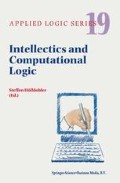Abstract
The major goal of Artificial Intelligence (AI) is to investigate natural and artificial intelligence.
Access this chapter
Tax calculation will be finalised at checkout
Purchases are for personal use only
Preview
Unable to display preview. Download preview PDF.
References
Anderson, J. (1995). Cognitive psychology and its implications. Freeman.
Arbib, M. (1995). Handbook of Brain Theory and Neural Networks. MIT Press.
Basar-Eroglu, C., Strüber, D., Schürmann, M., Stadler, M., and Basar, E. (1996). Gamma-band responses in the brain: a short review of psychophysiological correlates and functional significance. International Journal of Psychophysiology, 24: 101–112.
Bargas, J. and Galarrage, E. (1995). Ion channels: Keys to neuronal specialization. In (Arbib, 1995), pages 496–501.
Bibel, W. (1992a). Deduktion: Automatisierung der Logik. Vieweg.
Bibel, W. (1992b). Intellectics. In (Shapiro, 1992), pages 705–706.
Bryson, A. and Ho, Y.-C. (1969). Applied Optimal Control. Blaisdell.
Bugmann, G. (1997). Biologically plausible neural computation. Biosystems, 40 (1–2): 11–19.
Churchland, P. and Sejnowski, T. (1992). The computational brain. MIT Press.
Dudel, J., Menzel, R., and Schmidt, R. (1996). Neurowissenschaft. Springer.
Eckhorn, R., Dicke, E, Kruse, W., and Reitböck, H. (1990). Stimulus-related facilitation and synchronization among visual cortical areas: experiments and models. In Schuster, H. and Singer, W., editors, Nonlinear Dynamics and Neural Networks,pages 57–75. VCH.
Engel, A., König, P., Kreiter, A., Schillen, T., and Singer, W. (1992). Temporal coding in the visual cortex: new vistas on integration in the nervous system. Trends in Neuroscience, 15 (6): 218–226.
Gray, C. and Singer, W. (1989). Stimulus-specific neuronal oscillations in orientation columns of cat visual cortex. Proceedings of the National Academy of Sciences USA, 86: 1698–1702.
Gray, P. and Meyer, R. (1984). Analysis and Design of Analog Integrated Circuits. John Wiley and Sons. Greger, R. and Windhorst, U. (1996). Comprehensive Human Physiology. Springer.
Grossberg, S. (1995). Figure-ground separation. In (Arbib, 1995), pages 395–399.
Hansel, D., Mato, G., Meunier, C., and Neltner, L. (1998). On numerical simulations of integrate-and-fire neural networks. Neural Computation, 10 (2): 467–483.
Herrmann, C. S. (1995). A hybrid fuzzy-neural expert system for diagnosis. In Mellish, C. S., editor, Proceedings of the 14th International Joint Conference on Artificial Intelligence (IJCAI),pages 494–500. Morgan Kaufman.
Herrmann, C. S. (1996). Ein hybrides KI-System zur medizinischen Diagnose: am Beispiel der Elektroenzephalographie. PhD thesis, TH Darmstadt, FG Intellektik. DISKI 145, Infix Verlag, St. Augustin.
Herrmann, C. S., Pfeifer, E., and Mecklinger, A. (1998). Gamma-oscillations during perception of illusory contours. International Journal of Psychophysiology, 30 (1–2): 133–134.
König, P., Engel, A., and Singer, W. (1996). Integrator or coincidence detector? the role of the cortical neuron revisited. Trends in Neuroscience, 19 (4): 130–137.
Maass, W. (1997). Networks of spiking neurons–the third generation of neural network models. Neural Networks, 10 (9): 1659–1671.
McCulloch, W., Pitts, W. (1943). A logical calculus of the ideas immanent in nervous activity. Bulletin of Mathematical Biophysics.
Minsky, M. and Papert, S. (1969). Perceptrons: An Introduction to Computational Geometry. MIT Press.
Niedermeyer, E. , Lopes da Silva, F. (1993). Electroencephalography, Basic Principles, Clinical Applications and Related Fields. William and Wilkins.
Norman, D., Rumelhardt, D. (1975). Explorations in Cognition. Freeman.
Phillips, W., Singer, W. (1997). In search of common foundations for cortical computation. Behavioral and brain Sciences, 20: 657–722.
Rumelhart, D., McClelland, J. (1986). Parallel Distributed Processing: Explorations in the Microstructure of Cognition. MIT Press.
Schmidt, R. and Thews, G. (1990). Physiologie des Menschen. Springer.
Segev, I. (1995). Dendritic processing. I n (Arbib, 1995), pages 282–288.
Shapiro, S. C. (1992). Encyclopedia of Artificial Intelligence. John Wiley.
Shastri, L. and A11anagadde, V. (1993). From associations to systematic reasoning: A connectionist representation of rules, variables and dynamic bindings using temporal synchrony. Behavioural and Brain Sciences, 16 (3): 417–494.
Softky, W. and Koch, C. (1995). Single-cell models. In (Arbib, 1995), pages 879–884.
Sternberg, R. (1996). Cognitive Psychology. Harcours Brace.
Talion-Baudry, C., Bertrand, O., Wienbruch, C., Ross, B., and Pantev, C. (1997). Combined EEG and MEG recordings of visual 40 Hz responses to illusory triangles in human. Neuroreport, 8: 1103–1107.
Tamas, G., Buhl, E., and Somogyi, P. (1997). Massive autaptic self-innervation of gabaergic neurons in cat visual cortex. Journal of Neuroscience, 17 (16): 6352–6364.
Zadeh, L. (1965). Fuzzy sets. Information and Control, 8: 338–353.
Author information
Authors and Affiliations
Editor information
Editors and Affiliations
Rights and permissions
Copyright information
© 2000 Springer Science+Business Media Dordrecht
About this chapter
Cite this chapter
Herrmann, C.S. (2000). AI and Cognitive Science: Feedback Leads to a New Neural Concept. In: Hölldobler, S. (eds) Intellectics and Computational Logic. Applied Logic Series, vol 19. Springer, Dordrecht. https://doi.org/10.1007/978-94-015-9383-0_11
Download citation
DOI: https://doi.org/10.1007/978-94-015-9383-0_11
Publisher Name: Springer, Dordrecht
Print ISBN: 978-90-481-5438-8
Online ISBN: 978-94-015-9383-0
eBook Packages: Springer Book Archive

